 W
WAlfaro is a genus of poeciliid fishes endemic to Central America. The generic name honours the Costa Rican archaeologist, geologist, ethnologist, zoologist and Director of the National Museum of Costa Rica, Anastasio Alfaro (1865-1951).
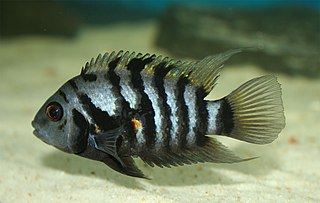 W
WAmatitlania is a genus of cichlid fishes from Central America from El Salvador and Guatemala to Panama. The genus is closely related to Archocentrus and Cryptoheros, and contains the convict cichlids that were previously placed in those genera. The genus was erected by Juan Schmitter-Soto in 2007 based on a study of the Archocentrus complex. However, a 2008 study led by Oldrich Rican has suggested that all the species in Cryptoheros and Amatitlania should be moved into the genus Hypsophrys.
 W
WAmatitlania sajica, the T-bar cichlid or Sajica cichlid, is a Central American species of cichlid found in freshwater streams and lakes on the Pacific slope of Costa Rica. The fish is tan colored with seven indistinct bars on the body. The third bar is usually prominent and coupled with a dark lateral stripe running from the gill cover results in a horizontal T-shaped mark, hence the common name of T-bar cichlid.
 W
WAmphilophus is a genus of cichlid fishes from Central America, ranging from southern Mexico to Panama. The genus currently contains 23 species, including several that are well-known from the aquarium trade. However, studies led by Oldrich Říčan in 2008 and 2016 suggested that several species within Amphilophus should be moved to the genus Astatheros. Species proposed to be moved to Astatheros in 2008 were A. alfari, A. altifrons, A. bussingi, A. diquis, A. longimanus, A. macracanthus, A. margaritifer, A. rhytisma, A. robertsoni and A. rostratus. Further genetic studies led Říčan to put A. macracanthus in Astatheros, but to put A. alfari, A. altifrons, A. bussingi, A. diquis, A. longimanus, A. rhytisma, A. robertsoni and A. rostratus within the genus Cribroheros. Říčan's study suggests that the Astatheros species are more closely related to the Jack Dempsey and rainbow cichlid than to the remaining Amphilophus species.
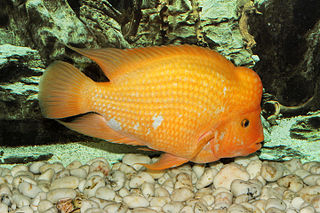 W
WAmphilophus citrinellus is a large cichlid fish endemic to the San Juan River and adjacent watersheds in Costa Rica and Nicaragua. In the aquarium trade A. citrinellus is often sold under the trade name of Midas cichlid. A. citrinellus are omnivorous and their diet consists of plant material, molluscs and smaller fish. The species is closely related to but not to be mistaken as Amphilophus labiatus, who both shares the nickname red devil cichlid.
 W
WArchocentrus is a genus of cichlid fishes from Central America. It formerly included 7 of the species now included in the genus Cryptoheros, as well as the convict cichlid, now included in the genus Amatitlania. The Rainbow Cichlid, Archocentrus multispinosus, was temporarily included in the genus Archocentrus but is now back in its original genus Herotilapia.
 W
WThe blackfin sorcerer is a species of saltwater eel in the family Nettastomatidae of the order Anguilliformes. It is found only in the Atlantic Ocean and the Mediterranean Sea.
 W
WBrachyrhaphis is a genus of poeciliids native to freshwater habitats in Central America. Most are restricted to Panama and Costa Rica, but B. holdridgei also occurs in Nicaragua and B. hartwegi is from Mexico and Guatemala. A recent phylogenetic analysis has suggested that Brachyrhaphis may not be of a monophyletic group.
 W
WThe yellow longnose butterflyfish or forceps butterflyfish, Forcipiger flavissimus, is a species of marine fish in the family Chaetodontidae.
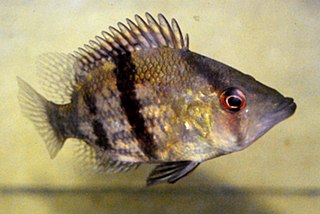 W
WCaquetaia is a small genus of cichlid fishes from tropical South America. The genus currently contains three species. Caquetaia spp. are ambush predators that predominately feed on invertebrates. Seasonal fluctuations in water level have been shown to contribute to Caquetaia spp. consuming a larger variety of invertebrates, especially when the water level is low during dry seasons. Caquetaia are known for their highly protrusible jaws, an adaptation hypothesized to improve their ability to capture prey by enhancing overall ram velocity.
 W
WThe Ictaluridae, sometimes called ictalurids, are a family of catfish native to North America, where they are an important food source and sometimes fished for sport. The family includes about 51 species, some commonly known as bullheads, madtoms, channel catfish, and blue catfish.
 W
WCathorops is a genus of catfishes in the family Ariidae found in the Atlantic and Pacific Oceans. These species are found in the eastern and western Central and South America in brackish and freshwater habitats. This genus is a strongly supported clade of this family. It consists of a natural group in which the monophyly is well-defined by morphological and molecular evidence and the genus probably includes several unrecognized species from both American coasts.
 W
WCharaciformes is an order of ray-finned fish, comprising the characins and their allies. Grouped in 18 recognized families, more than 2000 different species are described, including the well-known piranha and tetras.
 W
WThe convict cichlid is a fish species from the family Cichlidae, native to Central America, also known as the zebra cichlid. Convict cichlids are popular aquarium fish and have also been the subject of numerous studies on fish behaviour.
 W
WThe Ctenoluciidae, also known as pike-characins, are a small family of freshwater fishes from Panama and South America.
 W
WCypriniformes is an order of ray-finned fish, including the carps, minnows, loaches, and relatives. This order contains 11-12, although some authorities have designated as many as 23, families over 400 genera, and more than 4,250 species, with new species being described every few months or so, and new genera being recognized frequently. They are most diverse in southeastern Asia, and are entirely absent from Australia and South America. At 112 years old, the longest-lived cypriniform fish documented is the bigmouth buffalo.
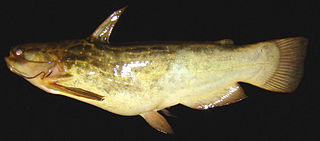 W
WThe driftwood catfishes are catfishes of the family Auchenipteridae. The two genera of the former family Ageneiosidae have been placed here, resulting in a grouping of about 125 species in about 22 genera.
 W
WThe four-eyed fishes are a genus, Anableps, of fishes in the family Anablepidae. They have eyes raised above the top of the head and divided in two different parts, so that they can see below and above the water surface at the same time.
 W
WThe longnose killifish is a marine tropical benthopelagic fish of the genus Fundulus and the family Fundulidae. It is endemic to the western Atlantic Ocean, ranging from along the coast of the Gulf of Mexico from the Florida Keys to Tampico in Mexico. It can grow up to 12 centimeters in length. The body is rounded, elongate, and olive to silver colored with dark vertical stripes. It can be distinguished from other killifish by its long snout and a dark spot on last vertical bar. This species requires to be allocated a new binomial as Fundulus similis is preoccupied by a junior synonym of Fundulus majalis, the name having been given to a Gulf of Mexico population of that species.
 W
WGars are members of the Lepisosteiformes, an ancient holosteian order of ray-finned fish; fossils from this order are known from the Late Jurassic onwards. The family Lepisosteidae includes seven living species of fish in two genera that inhabit fresh, brackish, and occasionally marine, waters of eastern North America, Central America and the Caribbean islands. Gars have elongated bodies that are heavily armored with ganoid scales, and fronted by similarly elongated jaws filled with long, sharp teeth. Gars are sometimes referred to as "garpike", but are not closely related to pike, which are in the fish family Esocidae. All of the gars are relatively large fish, but the alligator gar is the largest – the alligator gar often grows to a length of over 2 m (6.5 ft) and a weight of over 45 kg (100 lb), and specimens of up to 3 m (9.8 ft) in length have been reported. Unusually, their vascularised swim bladders can function as lungs, and most gars surface periodically to take a gulp of air. Gar flesh is edible and the hard skin and scales of gars are used by humans, but gar eggs are highly toxic.
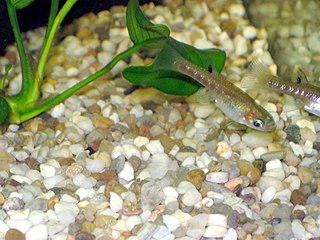 W
WGirardinus is a genus of poeciliids native to Cuba. The name of this genus honours the French zoologist Charles Frédéric Girard (1822-1895) for his work on the freshwater fish of North America.
 W
WHeterandria is a genus of livebearing fishes within the family Poeciliidae. Most species occur in Guatemala and its surroundings, particularly Mexico, but the midget livebearer (H. formosa) comes from the southeastern United States.
 W
WHoplias microlepis is a species of trahira found in Central and South America.
 W
WHypsophrys is a small genus of cichlid fishes from Central America.
 W
WHypsophrys nicaraguensis, the moga, is a species of cichlid native to the Atlantic slope of Central America, from Nicaragua to Costa Rica. The species is a popular aquarium fish and is traded under a variety of common names that include nickie, parrot cichlid, macaw cichlid, butterfly cichlid and nicaraguense. In Costa Rica it is known as a vieja.
 W
WThe liberty molly is a fish species from El Salvador. It is one of the short fin molly species in the Poecilia sphenops complex, and had been often regarded as a variety of P. sphenops until recently.
 W
WMesoheros is a genus of cichlids. It is found in Colombia, Ecuador, and Peru; Atrato River flowing into the Atlantic, San Juan, Baudó and Patia Rivers to Esmeraldas and Tumbes Rivers flowing into the Pacific.
 W
WThe naked-back knifefishes are a family (Gymnotidae) of knifefishes found only in fresh waters of Central America and South America. All have organs adapted to the exploitation of bioelectricity. The family has about 40 valid species in two genera. These fish are nocturnal and mostly occur in quiet waters from deep rivers to swamps. In strongly flowing waters, they may bury themselves.
 W
WParachromis is a genus of cichlids native to Central America. Some species occur in Lake Nicaragua and Lake Managua. All species are predatory and relatively large for cichlids.
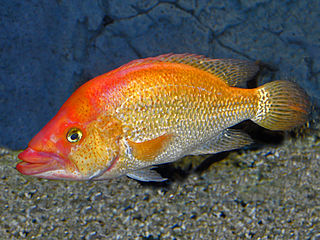 W
WPetenia splendida, the Bay snook, is a species of cichlid from Mexico and northern Central America. It is important to local commercial fisheries.
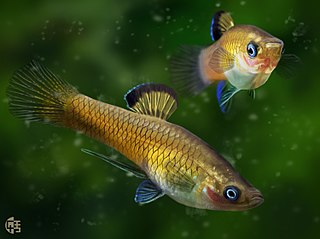 W
WPhallichthys is a genus of poeciliids native to Central America.
 W
WThe poor man's tropheus is a species of fish in the family Cichlidae. Until 2007 it was the only species in the genus Neetroplus, but at that time it was reclassified into the genus Hypsophrys. In 2016 it was restored to the genus Neetroplus based on genetic research by Říčan, et al.
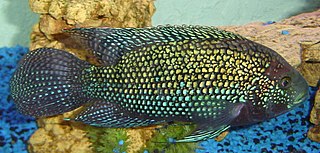 W
WRocio is a small genus of cichlid fishes from Mexico and northern Central America.
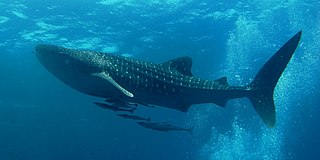 W
WThe whale shark is a slow-moving, filter-feeding carpet shark and the largest known extant fish species. The largest confirmed individual had a length of 18.8 m (62 ft). The whale shark holds many records for size in the animal kingdom, most notably being by far the largest living nonmammalian vertebrate. It is the sole member of the genus Rhincodon and the only extant member of the family Rhincodontidae, which belongs to the subclass Elasmobranchii in the class Chondrichthyes. Before 1984 it was classified as Rhiniodon into Rhinodontidae.
 W
WThe plainfin sole is a sole of the genus Achirus native to the western Atlantic in the Caribbean Sea and along the coast of the Americas from Belize to Santa Catarina, Brazil. This demersal species inhabits soft bottoms near the shores or estuaries. It growth up to 18.7 cm (7.4 in).
 W
WSturisomatichthys is a genus of armored catfishes native to Central and South America.
 W
WThorichthys is a genus of cichlids. It is found in Atlantic slope of Middle America from Chachalacas River area in Mexico, south to the Motagua River drainage in Guatemala and Honduras. They have somewhat pointy heads and stripes down their body, and tend to inhabit slow-moving or standing water. The best-known species is Thorichthys meeki, the firemouth cichlid. Members of Thorichthys do not exceed 17 cm (6.7 in), making them popular aquarium fish. They are most closely related to Salvin's cichlid of the genus Trichromis.
 W
WTrichomycterus is a genus of fish in the family Trichomycteridae, the largest genus of its family with over 170 species currently described. This genus is native to freshwater habitats in Central and South America. These fish are generally small, usually about 5 to 15 cm (2–6 in) in standard length, although the largest, T. rivulatus, can reach more than twice this size. Species differ from one another primarily in body proportions, fin ray counts and colouration. Despite their relatively small size, some, such as T. punctulatus, support fisheries and are important in the local cuisine.
 W
WVieja is a genus of cichlid fish from the Pacific slope of Central America and Mexico. The majority of the species are freshwater fish found in stagnant or slow-moving waters of southern Mexico to El Salvador, but V. maculicauda, which also occurs in brackish waters, ranges south to Panama. They are high-bodied cichlids that reach lengths of up to 17–35 cm (6.7–13.8 in) depending on the exact species. Historically, Vieja was included in Cichlasoma. Once recognized as its own genus, it first included most of the superficially similar, relatively large and high-bodied cichlids of Central America and southern Mexico, but several of these are now considered to belong to separate genera: Chuco, Cincelichthys, Isthmoheros, Kihnichthys, Maskaheros and Oscura. Vieja feed mostly on vegetable matter, but may also take small invertebrates.
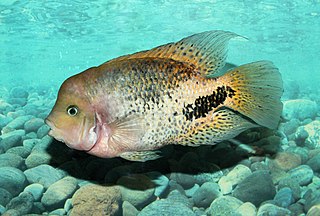 W
WVieja melanura, the quetzal cichlid, redhead cichlid or firehead cichlid, is a species of cichlid native to Central America where it occurs in the Usumacinta River drainage in the countries of Mexico, Belize and Guatemala. This species can reach a length of 35 centimetres (14 in) TL. It is also popular in the aquarium trade.